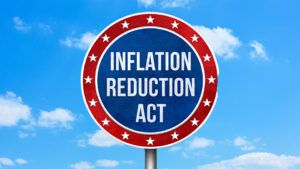On 16 August 2022, the US established the Inflation Reduction Act, providing $500bn in new spending and tax breaks to kickstart the US economy.
According to global management consulting firm McKinsey, the act aims to generate investments in green technology, encourage a boost in domestic manufacturing capacity and mandate recipients of the many funding streams to demonstrate equity impacts.
“The American people won, and the climate deniers lost,” said US president, Joe Biden, on the passage of the act. “The Inflation Reduction Act takes the most aggressive action to combat the climate crisis – as the Speaker said – ever, ever, ever.”
Given this optimistic assessment, ESG Clarity asked experts in the investment industry how the Inflation Reduction Act has changed the landscape for sustainable finance, on the occasion of its one-year anniversary.

Levelling the playing field
Leslie Samuelrich, president at Green Century Funds
We already invest in some clean energy companies and have become more bullish on their prospects because of the Inflation Reduction Act. We are expecting the IRA to help companies in the clean energy generation and storage industries to grow, and we are excited to already hold some in our portfolio while looking at others more closely.
The Inflation Reduction Act is giving investors who have shied away from the renewable energy industry the chance to support them now, as well as helping companies leading the clean energy transition to be able to deliver competitive returns.
It has levelled the field so that clean energy companies are more attractive not only for environmentally minded investors but also for mainstream ones. There is every reason to look at companies poised to benefit with fresh eyes.

Positive impacts for growth, profitability and valuation
Jake Schwartz, senior equity analyst at Karner Blue Capital
The Inflation Reduction Act dramatically improved the economics of renewable energy projects through a 10-year extension of existing tax credits, introduction of new tax credits, and other favourable tax regime changes. Naturally, these changes have had major implications for publicly traded companies in the renewable energy space who either develop, own or operate renewable projects, or produce equipment used in those projects.
As such, our assessment of these companies takes into account this new favourable tax regime, which positively impacts expected growth, profitability and valuation. Broadly, the Inflation Reduction Act (as well as other country and state level incentives) reflects the common social desire for a clean energy future, and meaningfully incentivises company participation in that future.

‘No chasing policy sentiment’
Deirdre Cooper, head of sustainable equity at Ninety One
We would never adjust our investment process based on any one piece of policy. However, deep understanding and analysis of current policy and the potential future direction of policy around the world is a key part of our investment process. That covers not only federal US policy but state and city level incentives. It includes EU policy, but also measures in each country, and we have spent time with regulators across the world in China (both Beijing and regional), India and South Africa. This analysis drives our sector models, which drive our underlying company models.
We do not do top-down allocation to a market to chase policy sentiment, rather we drive our earnings and cash flow forecasts from our deep understanding of policy, technology and consumer behaviour and then allocate to companies where we have the most valuation upside – which may not always be listed in the home market.

A powerful economic tailwind
Ashish Bhardwaj, co-portfolio manager of the Fidelity American Special Situations Fund
The Inflation Reduction Act is a powerful stimulus tool, which is encouraging investment in many clean energy projects in the US, while simultaneously encouraging corporates to onshore the clean energy value chain, bringing industry back to the US. This is being achieved via multiple different financial schemes, adding up to $400bn of fiscal support from the Federal Government. The Inflation Reduction Act is only one component of the stimulus policies announced by the US government over the past two years. The government has also announced policies to inject about $550bn of new money into infrastructure projects across roads, rails, ports, as well as $280bn into the semiconductor industry via the CHIPS Act.
These schemes will result in 2% to 3% of additional fixed asset investment growth in the US over the next few years. These schemes have given us a high degree of confidence in onshoring and clean energy investments in the US, and we have already seen many mega projects being announced over the past 12 months, ranging from electric vehicle battery plants to solar module factories. These schemes, including the Inflation Reduction Act, will prove to be a powerful economic tailwind over the next decade for the US economy.

Robust demand and strong end markets
Andrew Smith, client portfolio manager, US equities at Columbia Threadneedle Investments
Although the Inflation Reduction Act has not changed how we invest or think about companies, it has definitely had an impact on where we invest. Despite the negative headlines about impending recession, we have continued to observe that some parts of the economy – particularly the industrial sector – have continued to perform very well.
Demand is robust and end markets are strong, especially now that supply chain issues have normalised. The Inflation Reduction Act has played a key role in creating this supportive backdrop in terms of offering tax breaks for companies which are deploying clean technologies. In our portfolios, we have long been supporters of companies that are enabling the future by providing the technology and resources needed to unlock cleaner forms of energy production and to minimise impact on the environment.
